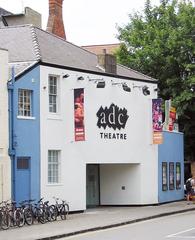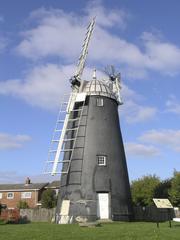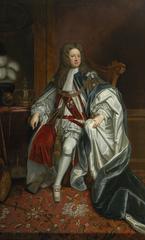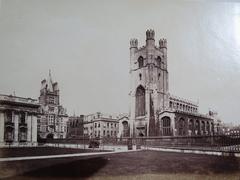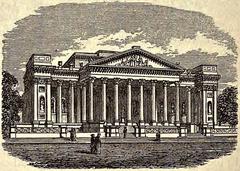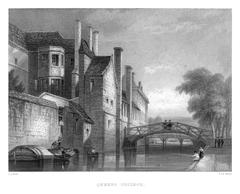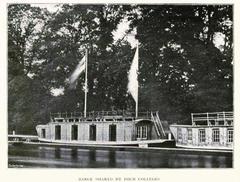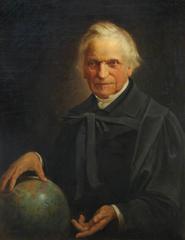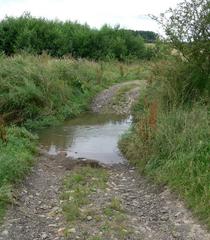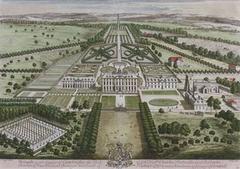
Commemorative Plaque to Clara Dorothea Rackham: Visiting Hours, Tickets, and Guide in Cambridge
Date: 03/07/2025
Introduction
The blue plaque commemorating Clara Dorothea Rackham stands in Cambridge as a powerful tribute to a pioneering social reformer and suffragist. Clara Rackham (1875–1966) devoted her life to advancing women’s rights, social justice, and public service, leaving a lasting legacy both locally and nationally. The plaque forms part of the Cambridge Blue Plaque scheme, which recognizes figures who have made enduring contributions to the city’s history (Cambridge, Past, Present & Future Blue Plaques).
Located at 9 Park Terrace, Cambridge, this plaque marks the home where Rackham lived during her most significant years of activism. The site offers a meaningful connection to her work, and is close to central Cambridge attractions, making it an ideal stop for history enthusiasts, researchers, and curious travelers. This guide outlines the historical significance, visitor information, accessibility, and practical tips for making the most of your visit to the Clara Rackham plaque.
Who Was Clara Dorothea Rackham?
Clara Dorothea Rackham (née Tabor) was born in London in 1875 and educated at Notting Hill High School, St Leonards School, Bedford College, and Newnham College, Cambridge. Her early exposure to progressive ideals and university life shaped her lifelong commitment to social reform. Rackham became a leading advocate for women’s suffrage, labor rights, birth control, and educational access. Her leadership roles included serving as president of the Cambridge Women’s Co-operative Guild, chairing the National Conference of Labour Women, and being a pioneering local councillor and magistrate (Wikipedia: Clara Rackham).
The Cambridge Blue Plaque Scheme
The Cambridge Blue Plaque scheme, managed by Cambridge, Past, Present & Future, celebrates individuals who have significantly contributed to the city’s heritage. Plaques are placed on buildings associated with these figures, providing public recognition and educational opportunities for residents and visitors.
Location, Address, and Access
- Plaque Location: 9 Park Terrace, Cambridge, CB1 1JJ (Capturing Cambridge: 9 Park Terrace)
- Accessibility: The plaque is mounted on the exterior of a private residence and is visible from the street at all times. The pavement is level and suitable for wheelchair users and strollers.
- Getting There: The site is close to Parker’s Piece, within walking distance from the city centre, Cambridge railway station, and major bus routes. Nearby car parks include Queen Anne Terrace, and ample bicycle parking is available.
- Nearby Public Transport: Parkside and Emmanuel Street bus stops are a short walk away (Visit Cambridge).
Visiting Hours and Ticket Information
- Opening Hours: The plaque is accessible 24/7 as it is outdoors.
- Admission: Free; no tickets are required.
- Best Times to Visit: For optimal lighting and fewer crowds, visit between 8:00 AM and 8:00 PM. Weekday mornings tend to be quieter.
What to Expect
The blue plaque is a round marker with the inscription:
“Clara Dorothea Rackham (1875–1966) Social Reformer, Labour Councillor, and Campaigner for Women’s Rights, lived here.”
There are no additional displays or visitor facilities on-site. Please respect the privacy of the residents by not entering the property or blocking entrances.
Guided Tours and Educational Resources
- Walking Tours: The Society of Cambridge Tourist Guides includes the Clara Rackham plaque in themed tours about Cambridge’s history and women’s suffrage (Society of Cambridge Tourist Guides).
- Self-Guided Options: Maps and resources are available from the Cambridge Visitor Information Centre and online via the Cambridge Blue Plaques map.
- Special Events: Occasional talks, performances, and commemorations are organised by local heritage groups, particularly around International Women’s Day and Cambridge heritage festivals (Cambridge Women’s History Group).
Significance and Cultural Context
Historical Impact
- Women’s Suffrage: Rackham was a leader in the peaceful suffrage movement, working with the National Union of Women’s Suffrage Societies to secure the vote for women.
- Labor and Education Reform: She championed workers’ rights, birth control, and adult education, including co-founding the Workers’ Educational Association (WEA) in Cambridge.
- Local Government: As a Cambridge councillor and magistrate, Rackham was instrumental in shaping local reforms in public health, welfare, and education.
Community Legacy
Rackham’s legacy is celebrated through named locations (such as Rackham Close and the community room at Milton Road Library) and ongoing recognition by women’s history groups. Her life’s work continues to inspire efforts to improve gender representation in heritage commemorations (English Heritage Blue Plaques).
Visitor Tips and Etiquette
- Photography: Permitted, but avoid photographing windows or interiors of the residence.
- Accessibility: Level pavements, dropped kerbs, and nearby accessible toilets ensure inclusivity.
- Weather: Cambridge weather can be unpredictable; bring suitable clothing.
- Refreshments: Numerous cafes and restaurants are available nearby on Regent Street and Mill Road.
- Combine Visits: The plaque is close to Parker’s Piece, the Fitzwilliam Museum, and several university colleges.
Frequently Asked Questions (FAQs)
Q: Can I visit inside 9 Park Terrace?
A: No, it is a private residence.
Q: Is there an admission fee or ticket required?
A: No, visiting the plaque is free and unticketed.
Q: Is the site wheelchair accessible?
A: Yes, pavements are level and suitable for mobility aids.
Q: Are guided tours available?
A: Yes, several walking tours feature the plaque, and private guides can customize visits.
Q: Can I take photos?
A: Yes, but please respect residents’ privacy.
Further Resources and References
- Capturing Cambridge: 9 Park Terrace
- Capturing Cambridge: 18 Hobson Street
- Wikipedia: Clara Rackham
- Cambridge, Past, Present & Future Blue Plaques
- Society of Cambridge Tourist Guides
- Cambridge Women’s History Group
- Cambridge Visitor Information Centre
- BBC News Coverage on Clara Rackham
- English Heritage Blue Plaques
Conclusion
The Clara Dorothea Rackham blue plaque is a vital part of Cambridge’s living history, offering a gateway to explore the achievements of a formidable campaigner for equality, education, and social reform. Its central location, accessibility, and connection to wider narratives of women’s history make it a must-visit for anyone seeking to engage with Cambridge’s progressive heritage. Enhance your visit by exploring nearby attractions, joining guided tours, or delving into digital resources. For more interactive guides and event updates, consider downloading the Audiala app.

